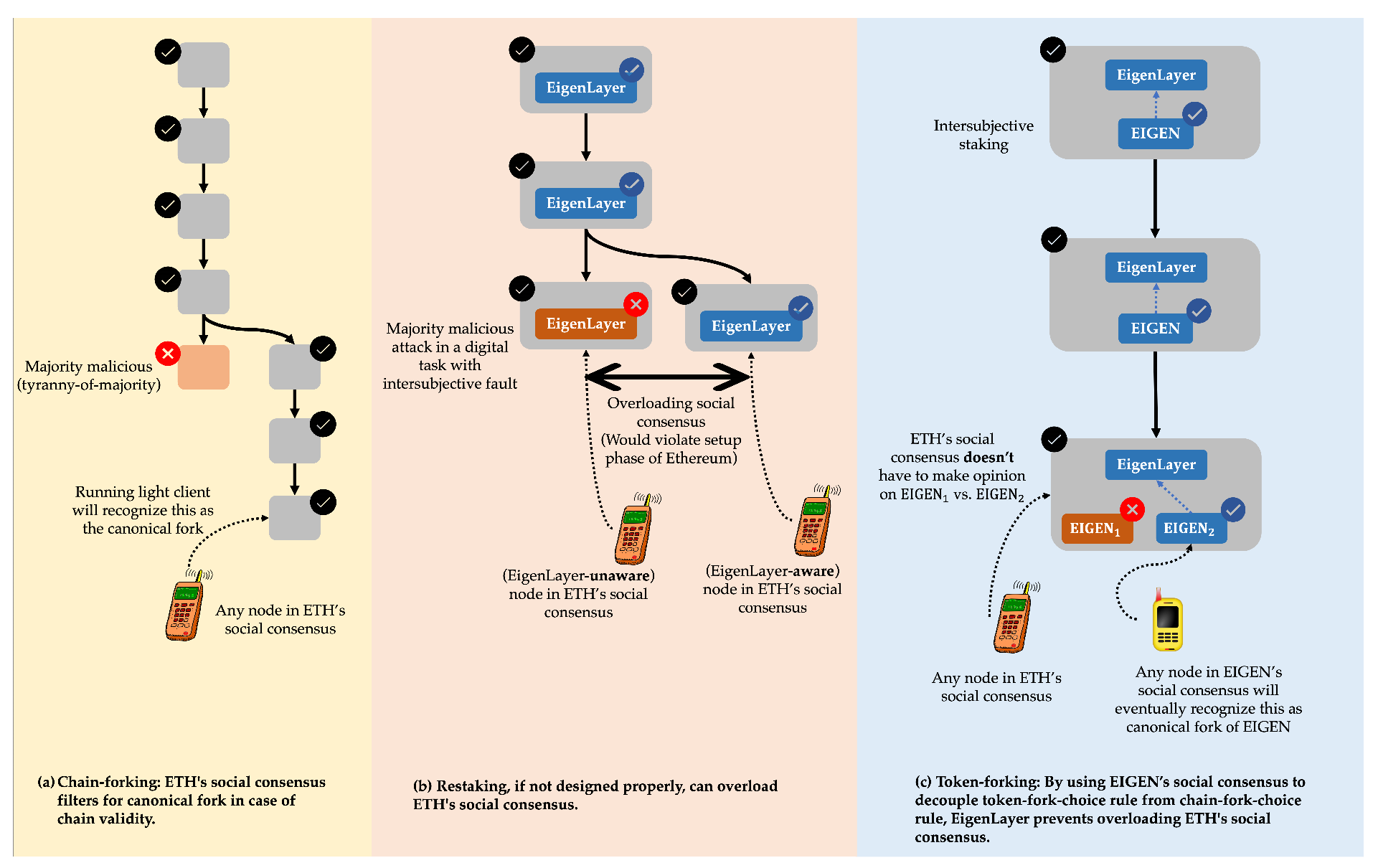Deep understanding of the significance of EigenLayer's Intersubjective staking: group subjectivity, majority tyranny, and forkable tokens
Original author: @Web3 Mario
Introduction: During the May Day holiday, Eigenlayer released its Eigen Token white paper. Strictly speaking, this is not a traditional economic white paper that aims to introduce incentive models and values, but it brings a brand new business system to everyone - Intersubjective staking based on Eigen Token. After reading the full text of the white paper (without reading the appendix in depth) and the interpretation of its predecessors, I have some of my own thoughts and understandings, and I hope to share them with you and look forward to everyone's discussion. First of all, I think the significance of Intersubjective staking lies in that it proposes a consensus system based on a forked ERC 20 token model, which can be used to make decisions on some "group subjectivity" issues, while avoiding the tyranny of the majority.
What is “group subjectivity”?
Correctly understanding Intersubjective is the prerequisite for understanding the meaning of the system. There seems to be no unified conclusion on the Chinese Internet about how to translate this word. After reading Mr. Pan Zhixiong's article, I quite agree that the concept of "social consensus" can indeed be used to understand its meaning well, but I think using "group subjectivity" to refer to this concept seems to be more consistent with the literal translation and easier to understand. Therefore, in the following text, I choose to use "group subjectivity" to refer to Intersubjective.
What exactly is "group subjectivity"? In the context of EigenLayer, it refers to the fact that there is a broad consensus among all active observers in a system on the right or wrong of the execution result of a certain transaction. Then this transaction is said to be intersubjective, that is, group subjectivity. We know that one of the core values of EigenLayer is to decouple the consensus layer from the execution layer and focus on the construction and maintenance of the former, so as to service the consensus, reduce the development cost of Web3 applications, and fully explore the potential needs of the market. In the narrative of the white paper, EigenLayer seems to position itself as a decentralized digital public platform that can perform digital tasks for third parties. Therefore, it is naturally necessary to analyze the boundaries of its services, that is, to clarify what types of digital tasks can be "trustedly" executed by it. In the context of Web3, "trusted" usually means that a system is designed by cryptography or economic models to avoid errors in the execution of digital tasks. Therefore, the first thing to do is to classify the possible execution errors of digital tasks. EigenLayer divides the execution errors of digital tasks into three categories:
Objectively attributable errors: This type of error refers to an execution error of a digital task that can be proven by a set of objectively existing evidence (usually on-chain data, or data with DA) through some kind of logical or mathematical deduction without relying on the trust of a specific subject. For example, in Ethereum, a node signed two conflicting blocks. This error can be proven by cryptography. Similar to this is the fraud proof process in OP Rollup, which re-executes a set of controversial data through the on-chain execution environment, and the error can be judged by comparing the results.
Group subjective attributable errors: This type of error refers to the execution error in which all participants in a system have consistent subjective judgment criteria for the execution results of a certain digital task. This type of error can be further divided into two categories:
An error that can be identified at any time by looking back at past data, such as a price oracle that the spot price of BTC on Binance was $1 at 00:00:00 UTC on May 8, 2024, can be identified at any time after the fact.
Errors that can only be observed in real time, such as malicious censorship, assume that a transaction is maliciously refused to execute by a group of nodes for a long time.
Unattributable errors: These errors refer to execution errors that do not have consistent judgment criteria among groups, such as judging whether Paris is the most beautiful city.
Intersubjective Staking is designed to effectively solve digital tasks with group subjectivity, which means it can handle digital task execution errors that can be attributed to group subjectivity. It can also be said to be an extension of the on-chain system.
The Tyranny of the Majority Problem with Current Solutions
The so-called tyranny of the majority is a political term that refers to the majority of seats in parliament jointly forcing the passage of policies, thereby infringing on the rights of the minority. After clarifying the goal of EigenLayer, let's take a look at the current types of solutions for such problems. According to EigenLayer's summary, there are two types:
1. Punishment mechanism: This type of mechanism usually uses cryptoeconomics to punish the staked funds of malicious nodes to deter malicious behavior. Staking slash is one of them. However, this method is prone to a problem. Imagine that when an honest node submits a proof of malicious behavior, but at this time most of the nodes in the system decide to conspire to do evil together, they can choose to ignore the proof or even punish the honest node in reverse.
2. Committee mechanism: This type of mechanism usually sets up a fixed group of committee nodes. In the event of a dispute, the committee nodes will verify the accuracy of the proof of malicious behavior. However, whether the committee is trustworthy becomes a big question. When the committee nodes conspire to do evil, the system will collapse.
Both solutions obviously encounter the problem of tyranny of the majority. This shows the difficulty of solving such problems. Although there is a consistent judgment on the accuracy of the execution results, due to the lack of objective verification capabilities, we can only shift from trusting cryptography or mathematics to trusting people. However, when most people choose to do evil, the current solutions are powerless.
Avoid majority tyranny through social consensus brought by forkable work tokens
So how does EigenLayer solve this problem? The answer is by designing a forkable work token on the chain, and based on the social consensus brought by the work token staking, it handles the subjective digital tasks of the group and avoids the problem of tyranny of the majority.
So what exactly is the so-called social consensus capability that forks can bring, and how does it avoid the tyranny of the majority? First of all, EigenLayer pointed out that the inspiration came from the research on ETH PoS consensus. It believes that the security of Ethereum comes from two aspects:
Cryptoeconomic security: By requiring block-producing nodes to pledge funds and designing a penalty mechanism for malicious behavior, the economic cost of doing evil exceeds the potential benefits to eliminate malicious behavior.
Social consensus: When a chain forks due to some malicious behavior, since there is a consistent judgment standard for the correctness of the execution results, any well-intentioned or honest user can choose the fork they think is correct based on their subjective observation of the execution results of different forks. In this way, even if the malicious node controls the majority of the pledged funds and the tyranny of the majority problem occurs, it will be accompanied by the abandonment of the malicious fork by users, so that the value of the forked chain will gradually surpass the malicious chain. For example, most CEXs will choose the correct forked chain with a small amount of pledge support, and abandon the wrong malicious chain with a large amount of pledge support. In this way, with the general social consensus, the value of the malicious chain will gradually disappear, and the forked chain will become the "orthodox fork" again.
We know that the essence of blockchain is to reach a consensus on the order of a group of transactions in a trustless distributed system. Ethereum has designed a serial execution environment EVM on this basis, so that when the transactions are consistent, EVM will reach a consistent execution result. EigenLayer believes that the evaluation of the execution results of such transactions is objectively attributable in most cases, but there are also cases where group subjectivity can be attributed. Specifically refers to the evaluation of the chain liveness dimension. There is a special Inactivity Leak mode in Ethereum's PoS consensus mechanism. When more than 1/3 of the nodes cannot produce blocks correctly due to some unknown circumstances, the crypto-economic security of PoS will be broken. An extreme example is that the entire Internet in a certain area is disconnected from another area due to war. Then Ethereum will fork. When the consensus mechanism discovers this situation, it will enter the Inactivity Leak mode. At this time, new blocks will not be given inflation rewards. At the same time, inactive nodes will be gradually slashed until the staked funds of active nodes exceed 2/3 again. This will gradually restore the crypto-economic security of the two forked chains.
After that, which chain will become the so-called "orthodox fork" can only rely on users to actively choose according to their own judgment criteria. This process is "social consensus". Then, with the active choice of users, the value of the two forks will shift until one fork wins the competition of cryptoeconomic security. This process can be regarded as security granted by social consensus.

To summarize this phenomenon, EigenLayer believes that Ethereum relies on social consensus to identify and resolve group subjective errors related to chain consistency, namely the so-called chain activity attacks. The core of this social consensus capability comes from forking. When a disagreement occurs, there is no hope to immediately determine which party is doing evil. Instead, subsequent users vote with their feet and rely on the ability of social consensus to resolve the disagreement. This avoids the problem of the protocol suffering from the tyranny of the majority, because a small number of honest nodes will not be conspired and immediately confiscated, which gives them the ability to make a comeback. This method demonstrates its value in judging problems involving group subjectivity.
Therefore, following this judgment, EigenLayer referenced and upgraded the consensus model of an on-chain gambling protocol called Augar, and proposed an on-chain forkable work token called EIGEN. An intersubjective staking mechanism was designed around EIGEN to resolve the execution consensus of subjective digital tasks of the group. When there is a disagreement on the execution results, the conflict is resolved by forking EIGEN and relying on social consensus in the subsequent time window. The specific technology is not complicated, and it has been introduced in some articles, so I will not discuss it here. I believe that understanding the above relationship can better grasp the meaning or value of Eigen intersubjective staking.



